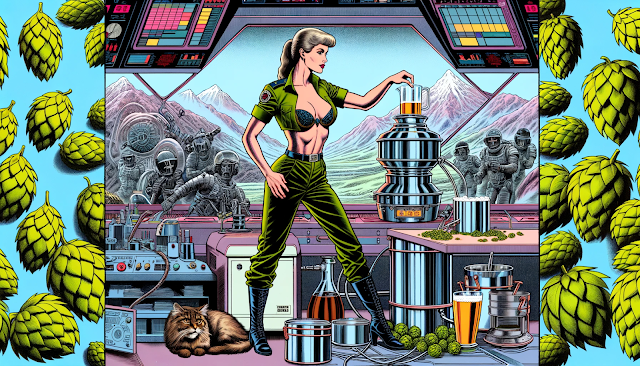Dry hopping, a technique revered in the craft beer world, involves the addition of hops to beer during or after fermentation, diverging from the traditional method of adding them during the boiling phase. This method significantly enhances the beer's aroma and flavor profile, offering a sensory experience without proportionally increasing its bitterness.
While dry hopping doesn't directly alter yeast metabolism, the introduction of hop oils into the mix can have various indirect effects. Hops are abundant in compounds known as hop oils, consisting of a spectrum of terpenes and volatile substances. These oils, especially in higher concentrations, can inhibit yeast growth and fermentation.
 |
| Keep to a tight dry hopping schedule... |
The Role of Myrcene and Other Terpenes
Myrcene is a crucial component within hop oils, known for its antimicrobial properties. It not only serves as an inhibitor of yeast growth but also exerts a considerable influence on the entire fermentation process. Beyond its antimicrobial functions, myrcene has the intriguing capacity to impact yeast metabolism by modifying the gene expression of these microorganisms.
This multi-faceted role of myrcene underscores its significance in the brewing process, as it contributes to the desired characteristics and flavors of the final product. Understanding the intricate interplay between myrcene and yeast in fermentation can greatly enhance the quality and consistency of brewed beverages.
Research Insights into Yeast Stress Responses
Recent studies have delved deeper into the consequences of dry hopping on yeast.
It's been observed that dry hopping can induce yeast stress responses, leading to significant changes in their gene expression and metabolic activities. A particularly interesting study highlighted that when the concentration of hops exceeds 2 g/L, there is a noticeable decrease in yeast cell viability and an increase in markers of oxidative stress.
Conversely, at hop concentrations below 1 g/L, yeast viability and oxidative stress levels appear to be stable and unaffected. This finding underlines the delicate balance brewers must strike to optimize the benefits of dry hopping while minimizing its impact on yeast health.
Navigating Dry Hopping Challenges for Home Brewers
For home brewers eager to employ dry hopping, several strategies can help mitigate the stress on yeast:
Selecting a Robust Yeast Strain
When it comes to popular brewing yeast names, several strains are widely recognized and used in the brewing industry:
- Saccharomyces cerevisiae: This is the most common yeast used in brewing and comes in various strains, each with its unique characteristics. For example, the Safale US-05 strain is known for its clean and neutral profile, making it suitable for a wide range of beer styles.
- Saccharomyces pastorianus: Lager yeast, which includes strains like W34/70 and Saflager S-23, is essential for brewing lagers. These strains ferment at cooler temperatures and contribute to the clean and crisp profile of lager beers.
- Saccharomyces bayanus: Champagne yeast, such as EC-1118, is sometimes used in specialty brews or for bottle conditioning due to its high alcohol tolerance.
- Brettanomyces: Commonly referred to as "Brett," this wild yeast strain is used deliberately in some beer styles, like sour ales and lambics, to impart unique funky and sour flavors.
- Ale and Lager Hybrids: Some yeast strains, like California Common (Wyeast 2112 or SafLager W-34/70), are versatile and can be used in both ale and lager styles, providing flexibility to brewers.
- Kveik: Originating from Norwegian farmhouse brewing traditions, Kveik strains, such as Voss Kveik or Hornindal Kveik, are known for their high-temperature tolerance and quick fermentation.
Hop Dose Management
The concentration of hop compounds plays a crucial role in yeast health. By carefully regulating the hop dose, brewers can reduce yeast stress and prevent off-flavors or undesirable aromas. Over-hopping can lead to negative effects, so moderation is key.
Maintaining Optimal Fermentation Temperatures
Yeast activity is highly sensitive to temperature changes. High temperatures can exacerbate yeast stress, so maintaining a consistent and appropriate fermentation temperature is critical during dry hopping.
This means don't cover your fermenting drum in tired old sheets and leave it in the garage over the hottest week of summer!
Learn from my experience and don't do that!
Incorporating Yeast Nutrients
In the intricate world of brewing, optimizing yeast health and functionality is a paramount consideration for brewers striving to craft exceptional beers. This pursuit often involves the strategic incorporation of yeast nutrients into the wort, such as yeast hulls or zinc.
These additions go beyond the simple provision of sustenance to the yeast; they serve as invaluable aids in bolstering yeast resilience throughout the fermentation process, especially when subjected to the unique stresses of dry hopping.
Yeast hulls, for instance, are essentially the cellular remains of yeast cells that have undergone autolysis. When introduced into the wort, they act as a source of essential nutrients, such as amino acids and lipids, which are vital for yeast growth and vitality. This nutrient boost not only fosters a healthier yeast population but also equips them to withstand the rigors of fermentation more effectively. Yeast hulls, in particular, can be especially beneficial when brewing high-alcohol or high-gravity beers, where yeast stress is more pronounced.
Zinc, on the other hand, plays a pivotal role in yeast metabolism. It functions as a cofactor for various enzymes involved in the fermentation process. By ensuring an adequate supply of zinc in the wort, brewers can promote yeast health and vigor, ultimately leading to more efficient fermentation and better attenuation.
Furthermore, when contemplating the inclusion of yeast nutrients like yeast hulls or zinc, brewers should consider the specific demands of their chosen beer style. Some styles may benefit more from these additions than others, and the dosage should be carefully calibrated to avoid over-supplementation, which could result in off-flavors.
Staged Hop Addition
the art of dry hopping is often accompanied by strategic decision-making to optimize flavor and aroma contributions without compromising the fermentation process. Instead of a single, all-encompassing hop addition, brewers can take a more nuanced and staggered approach, distributing the dry hop dose over several smaller additions. This method offers a multitude of benefits that extend beyond the mere enhancement of hop character in the final beer.
First and foremost, the staggered dry hopping technique minimizes yeast stress, a factor of paramount importance in brewing. When all the hops are added at once, a significant influx of hop compounds can disrupt the yeast's delicate equilibrium, potentially leading to stalled or incomplete fermentation. By dividing the dry hop dose into smaller portions, brewers allow the yeast to adapt gradually to the changing environment, reducing the shock factor and promoting a smoother fermentation process.
Furthermore, this approach enables better control over the extraction of hop flavors and aromas. Different hop compounds contribute various characteristics to the beer, and their solubility in alcohol and temperature sensitivity play crucial roles in their release. By introducing hops in stages, brewers can manipulate these factors to their advantage. For instance, the initial hop addition can emphasize more delicate and volatile aroma compounds, while subsequent additions can target specific flavor profiles, resulting in a more nuanced and balanced hop presence.
Additionally, staggered dry hopping offers a practical advantage by facilitating improved utilization of hop materials. Smaller hop additions allow for better contact between hops and beer, increasing the efficiency of extraction and reducing the potential for wastage.
Easy as conclusion
Despite these considerations, many brewers, including seasoned homebrewers, have successfully incorporated dry hopping into their brewing routines without significant concerns about its impact on yeast. Brewing, after all, is as much an art as it is a science, and the pursuit of the perfect brew often involves a blend of knowledge, experimentation, and intuition.


